New South Wales - Back O' Bourke, gateway to the outback
Australia So Much to See
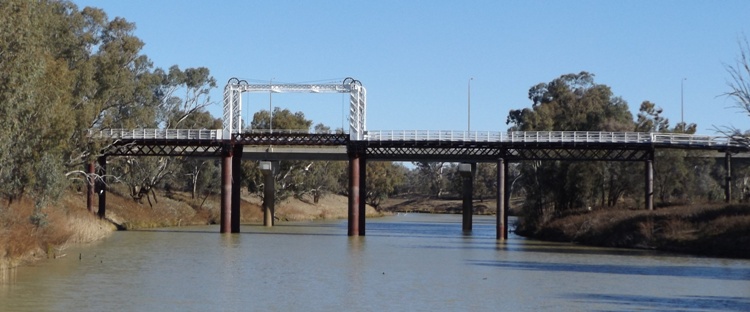
Below right as we approach the new bridge.
The 1883 North Bourke lift-span bridge crossing the Darling River, with the new bridge almost hidden behind it.
As we followed the Barwon River floodplain for much of the way from Brewarrina to Bourke, we were passing mainly through grazing land
of Beemery Station. Some patches were irrigated for cotton, with Clyde Cotton being the dominant name. They also grow
some winter crops of wheat and barley when rainfall allows. Clyde cotton, Beemery and a number of other stations are owned by
Peter Harris and family, of northern New South Wales. Overseas ownership of Clyde ceased when Peter Harris purchased the company
in 2014.
In the flat floodplains, we passed a prominent and very stony hill, Mount Druid. While not the highest
peak by altitude in the Brewarrina Shire at 166 metres, it is the highest by prominence, standing 51 metres above the surrounds.
Soon after the Barwon is joined by the Bogan River from the South, the Culgoa River converges from the north, after which the river
becomes the Darling River. The Culgoa River is a continuation of the western branch of the Balonne River in southern Queensland,
just north of Dirranbandi.
According to downstream farmers in 2008, large cotton farms, such as Cubbie Station in Queensland,
have reduced the traditional flow of the Culgoa River significantly. By 2009, downstream farmers where claiming that due to
upstream water entitlements on the Culgoa River, since 2000 the Lower Balonne floodplain had not received enough water to flood the
plains. Prior to the granting of these rights, the Lower Balonne River flooded every two or three years; impacting the sustainability
of flora, fauna, birdlife, and economic returns from grazing livestock and cropping. Cubbie Station, located on the Culgoa River,
is situated adjacent to a large diversion channel which permits the farm to store 460,000 megalitres of river water.
Once the largest inland port on the Darling River, the Bourke Wharf represents Bourke’s historic link with the river trade. It is
now a peaceful community place to view the Darling River.
The Bourke Wharf is a replica of one of the original wharves in Bourke.
In the late 1850s, the Darling River was opened up as a key transport route, and river communities like Bourke grew as important transport
centres.
There were once three wharves, each with a railhead. Bourke was a very busy wool loading port.
While
this wharf is a replica, it has been constructed showing how the design of the wharf catered for the varying levels of water that
occur on the Darling River. The multiple levels can now be visited by steps between the levels.
Bales of wool were
towed down the river by paddle steamers, but eventually, river transport was replaced when other forms of transport became available,
and the last commercial riverboat finished in 1931.
Looking downstream (below) and upstream (below right) at the Darling River from
the wharf. Water levels were low, only being what was held back by the Bourke Weir further downstream.
A number of
red-tailed cockatoos were sitting on the branches in the photo below.
Back O' Bourke is an Australia saying referring to the real outback or an extremely remote place. On our previous short visit
thirteen years before, we had come south from Cunnamulla, and stopped for the night well to the north of Bourke – truly meeting the
definition of Back O' Bourke.
Bourke is a medium sized town which once was the largest port on the Darling River, and a Cobb
and Co coach stop. Current population is around 2,300, with a total of 2,868 for the entire shire which covers 43,117 square
kilometres, the size of the European country Denmark.
The first Caucasian explorer to encounter the river
was Charles Sturt in 1828 who named it after Sir Ralph Darling, Governor of New South Wales. Having struck the region during an intense
drought and a low river, Sturt dismissed the area as largely uninhabitable and short of any features necessary for establishing reliable
industry on the land.
It was not until a visit by surveyor and explorer Sir Thomas Mitchell in 1835 that settlement of the area
began. Following tensions with the local people Mitchell built a small stockade to protect his men and named it Fort Bourke after
then Governor Sir Richard Bourke. This first crude structure became the foundation for a fledgling community with a small number of
agricultural and livestock farms established in the region shortly afterwards. The area started to flourish when its location on the
Darling River had it recognised as a key trade centre, linking the nearby outback agricultural industries with the east coast trade
routes via the Darling River.
Bourke was surveyed for a town in 1869 and soon established itself as the outback trade hub of
New South Wales with several transportation industries setting up branches in the town. By the 1880s Bourke would host a Cobb and
Co Coach terminus, several paddle boat companies plying the Darling, and a bridge crossing the river for road transport into the town.
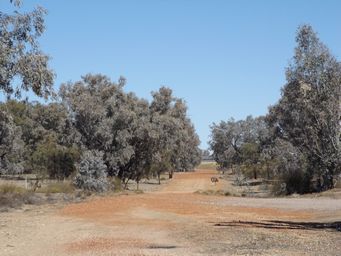
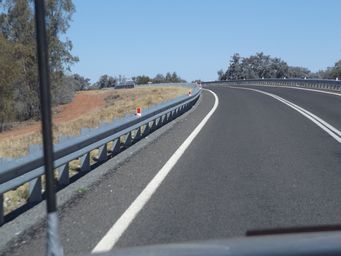
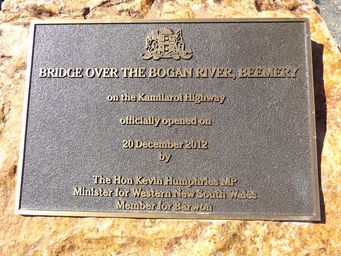
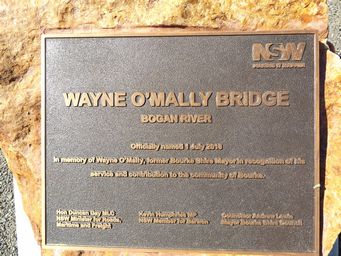
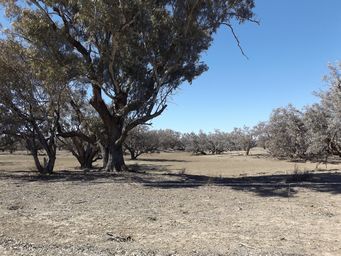
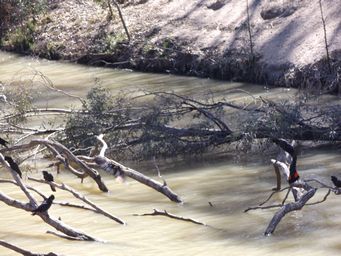
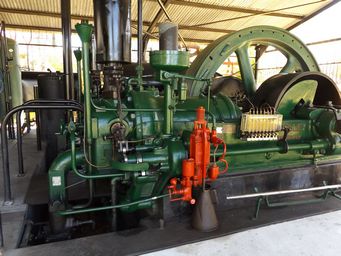
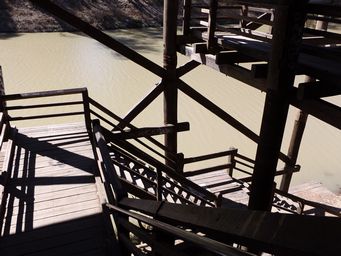
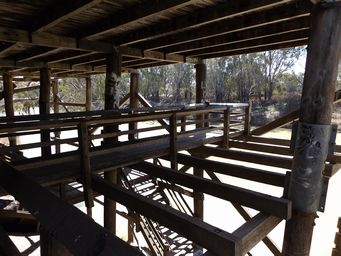
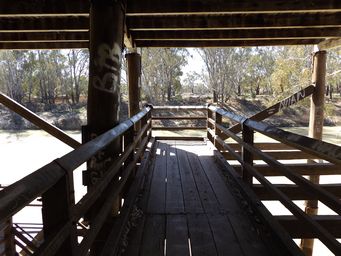
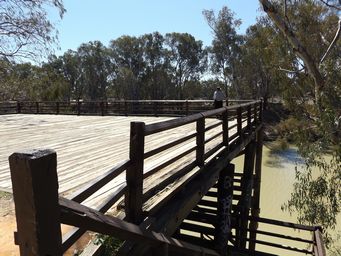
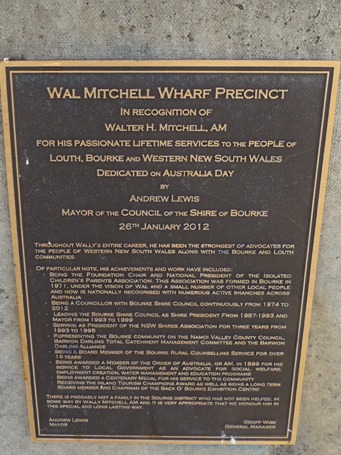
The Lock at the Bourke Weir was the first to be built on a river anywhere along with the Murray/Darling river systems. Built in 1897, and was designed to maintain a reasonable level of water in the river near the town. the lock measures 59.5 metres between gates and is 11 metres wide. It was concreted and converted into a weir in 1941. Located seven kilometres West of Bourke on Anson Street. While the river was low at the time of our 2017 visit, it was still navigable through the town, due to water held back by the weir.
Mitchell Caravan Park by the Kamilaroi Highway, close to the town centre.
Kidman’s Camp North Bourke with 100 powered site and two large areas for unpowered. 1.5 kilometres along Kidmans Way (Mitchell Highway) north east from the North Bourke Bridge.
Mays Bend free and unserviced campground for independent rigs on the Darling River. Accessed via Bullamunta
Road, from the Mitchell Highway ten kilometres north east of Bourke, with a further five kilometres along Bullamunta Road. Dry
weather access only. Large area by the river on a sweeping bend.
The is a dump point at the Back O' Bourke Exhibition and Visitor Centre car park. A further dump point in the southern side of town is not easy for big rigs to access.
We chose to stay at Gundabooka National Park on the Wilcannia Road, choosing the Yanda Campground by the Darling River. There is another smaller campground further south.
Update: Due to Covid restrictions, since June 2020, all national parks camping
must be booked, online via NSW National Parks or by phone on 1300 072 757. A $6 booking fee applies to all bookings, even
for campgrounds that do not charge a camping fee.